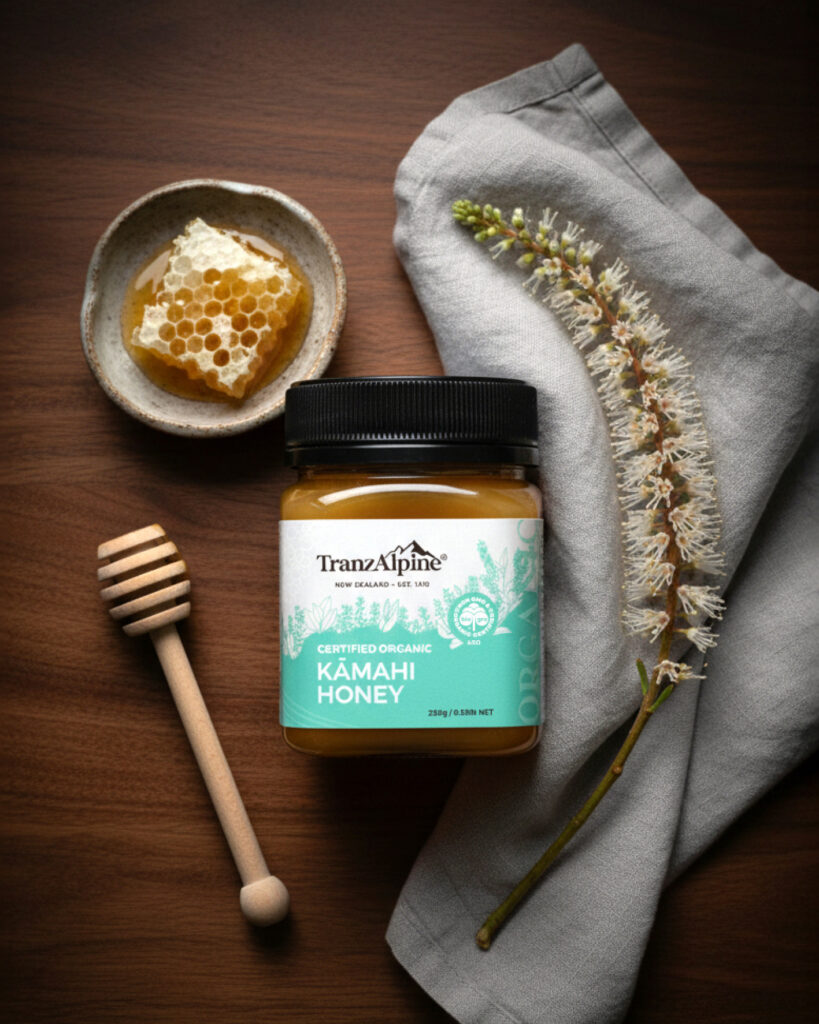
The festive summer flavours of Kāmahi honey
It’s a little-known fact that New Zealand has some of the most special and famous honey in the world. You probably already know about Mānuka honey; you might have heard about Kānuka honey, but have you ever tried our certified organic Kamahi Honey?
It’s a premium, native New Zealand honey known for its distinctively rich floral and nutty flavour profile. It smells like caramel toffee, with just a hint of vanilla. If you haven’t experienced this honey yet, you need to!
Kamahi trees come into flower in spring, in full bloom by late October to December, so it is the first honey of the summer season that we harvest each year.
Bees collect the nectar from the remote coastal rainforests tucked along the West Coast of the South Island of New Zealand. Feasting on the fluffy plumes of the white bottle brush type flowers of the Kamahi tree.
Kamahi honey is pale, rich and buttery and quite possibly the most underrated native New Zealand honey.
It pairs perfectly with cheeses like Camembert, Brie and Feta but is also packed with health benefits.
Ancient healing properties of honey
The Kamahi tree (Weinmannia racemosa) is a native New Zealand tree. Ancient traditional healers used the bark from this tree to treat coughs and colds, understanding the powerful, quick healing properties
Kamahi honey is naturally packed with anti-inflammatory and antibacterial qualities, and contains high levels of minerals, nutrients, and antioxidants.
Used in traditional medicine as a powerful tonic for respiratory tract illnesses such as flu and bronchitis, as well as for treating burns and skin ailments.
The best ways to eat Kāmahi honey
- Straight out of the jar with a spoon. No judgment from us!
- Drizzle over peanut butter toast, pancakes, French toast, crumpets and scones
- Mix with Greek yoghurt for a breakfast treat
- Add as a guilt-free sweetener to your coffee, frappe or tea
- Add honey to a scoop of peanut butter with a pinch of flake salt, and whip with a fork or whisk. Dip fruit or freeze for a sweet dessert.
- Blend with Sriracha to make crispy Brussels sprouts
- Add a generous helping and mix in with your everyday salad dressing
- Make honey an addition to your whipped herb butter. The perfect addition to put on just out of the oven, scones
- Chefs and cooks love Kāmahi honey for pairing with spicy dishes or drizzling over fresh fruit.
The connoisseur’s guide to New Zealand honey
New Zealand honey is unique, flavourful and packed with nutritional and wellness benefits, so it can be hard to know which honey to use for baking, sweetening or cooking, for boosting your immune system or helping with a sore throat, colds and flu.
Here is a quick guide to help you pick the best honey, but you really can’t go wrong with any of them.
| Feature | Kāmahi Honey | Mānuka Honey | Kānuka Honey | Rātā Honey |
| Source | Kamahi tree (Weinmannia racemosa) | Manuka bush (Leptospermum scoparium) | Kānuka tree (Kunzea ericoides) | Rātā tree (Metrosideros spp.) |
| Colour | Rich, amber colour. | Golden hues. | Buttery light to pale gold and amber. | White to very light creamy-golden. |
| Taste | Caramel-toffee, hints of vanilla; smooth and dessert-like. | Rich, floral. | Crisp, aromatic butterscotch. | Distinctive buttery vanilla sweetness with a hint of floral and a faintly salty note. |
| Aroma | Beautifully fragrant, smells like caramel or toffee, with just a hint of vanilla. | Earthy, aromatic. | Fruity, floral, caramel brulee. | Lightly floral with sweet, fruity notes. |
| Texture | Smooth and buttery soft. | Thick, creamy and smooth. | Velvety, silky, creamy and smooth. | Smooth, creamy, and elegant. |
| Beneficial Properties | Nutrient-rich, antioxidants, natural enzymes; moderate antibacterial activity. | High antibacterial activity (MGO), strong wound-healing properties. | Antibacterial and anti-inflammatory, wound and burn healing. | High antioxidant content, which helps fight free radicals, and its anti-inflammatory effects that support the immune system and digestive health. |
| Availability / Rarity | Seasonal, limited; harvested in remote NZ coastal rainforests. | Limited summer harvest Premium grades are rare and expensive. | Limited supply and short harvesting season. | Very rare because the Southern Rātā tree only flowers every 3-7 years, |
| Foodie Guide | Cheese pairing, desserts, drizzling over fruit, and toast. Great for spicy food. | Medicinal, healing, and respiratory support. Great for baking, breakfast and for marinating meat and fish. | Tea, smoothies, or as a spread, adds depth to dishes, and its unique flavour makes it an excellent base for marinades or dressings. | Pairs well with rich foods like goat cheese and chicken. A gourmet honey can be enjoyed on its own, sprinkled on yoghurt or fruit, or added to beverages like tea or coffee. |
Try organic Kāmahi Honey
Experience something a little bit different and try our organic Kamahi honey if you haven’t already. Available in 250g, 500g and 1kg jars. Use the batch code on each jar to trace your honey to the individual beehive your honey came from. Tell us what you love about it and share with us your favourite way to eat and enjoy it.
You might also like
Is Kanuka honey the next super-food?
Everything you need to know about Kāmahi honey
Recipe: Quick and easy lavender lemon honey bliss balls. Gluten and refined sugar-free.
Posted in Natural Health, Organic
Share:

